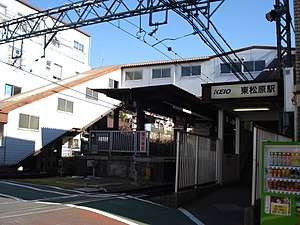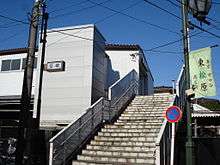Higashi-matsubara Station
Higashi-matsubara Station (東松原駅, Higashi-matsubara-eki) is a railway station on the Keio Inokashira Line in Setagaya, Tokyo, Japan, operated by the private railway operator Keio Corporation.
Higashi-matsubara Station 東松原駅 | |
|---|---|
 West entrance, May 2011 | |
| Location | Setagaya, Tokyo Japan |
| Operated by | Keio Corporation |
| Line(s) | Keio Inokashira Line |
| Other information | |
| Station code | IN07 |
| History | |
| Opened | 1933 |
| Traffic | |
| Passengers (FY2011) | 18,374 daily |
Lines
Higashi-matsubara Station is served by the 12.7 km Keio Inokashira Line from Shibuya in Tokyo to Kichijōji. Located between Shindaita and Meidaimae, it is 4.0 km from the Shibuya terminus.[1]
Service pattern
Only all-stations "Local" services stop at this station.
Station layout

The station consists of a ground-level island platform serving two tracks, with the station building built above the tracks.[2] On both the east and west ends (toward Shibuya and Kichijoji respectively), the exits are served by over-track bridges, between which is the station building. There are elevators from the south side of the east end of the station to the ground-level exit, and also between the ticket gate area and platforms.
The platform was previously only long enough to accommodate four 18-meter cars, with roads crossing the tracks at either end, and the station building on the western end. Later, the crossing on the eastern end was closed, the platform extended, and the existing station building was closed and rebuilt as an above-track station.
Platforms
| 1 | ■ Keio Inokashira Line | for Meidaimae, Eifukuchō, and Kichijōji |
| 2 | ■ Keio Inokashira Line | for Shimo-Kitazawa and Shibuya |
Adjacent stations
| « | Service | » | ||
|---|---|---|---|---|
| Keio Inokashira Line (IN07) | ||||
| Shindaita (IN06) | Local | Meidaimae (IN08) | ||
| Express: Does not stop at this station | ||||
History
The station opened on August 1, 1933.[1]
From 22 February 2013, station numbering was introduced on Keio lines, with Higashi-matsubara Station becoming "IN07".[3]
Passenger statistics
In fiscal 2011, the station was used by an average of 18,374 passengers daily.[4]
The passenger figures for previous years are as shown below.
| Fiscal year | Daily average |
|---|---|
| 1999 | 16,426[1] |
| 2010 | 18,529[4] |
| 2011 | 18,374[4] |
Surrounding area
- Hanegi Park
References
- Terada, Hirokazu (July 2002). データブック日本の私鉄 [Databook: Japan's Private Railways]. Japan: Neko Publishing. p. 206. ISBN 4-87366-874-3.
- Kawashima, Ryozo (April 2010). 日本の鉄道 中部ライン 全線・全駅・全配線 第1巻 東京駅―三鷹エリア [Railways of Japan - Chubu Line - Lines/Stations/Track plans - Vol 1 Tokyo Station - Mitaka Area]. Japan: Kodansha. pp. 10, 53. ISBN 978-4-06-270061-0.
- 京王線・井の頭線全駅で「駅ナンバリング」を導入します。 [Station numbering to be introduced on Keio Line and Inokashira Line] (PDF). News release (in Japanese). Keio Corporation. 18 January 2013. Retrieved 23 February 2013.
- 1日の駅別乗降人員 [Average daily station usage figures] (in Japanese). Japan: Keio Corporation. 2013. Retrieved 23 February 2013.
External links
| Wikimedia Commons has media related to Higashi-Matsubara Station. |
- Higashi-matsubara Station information (Keio) (in Japanese)